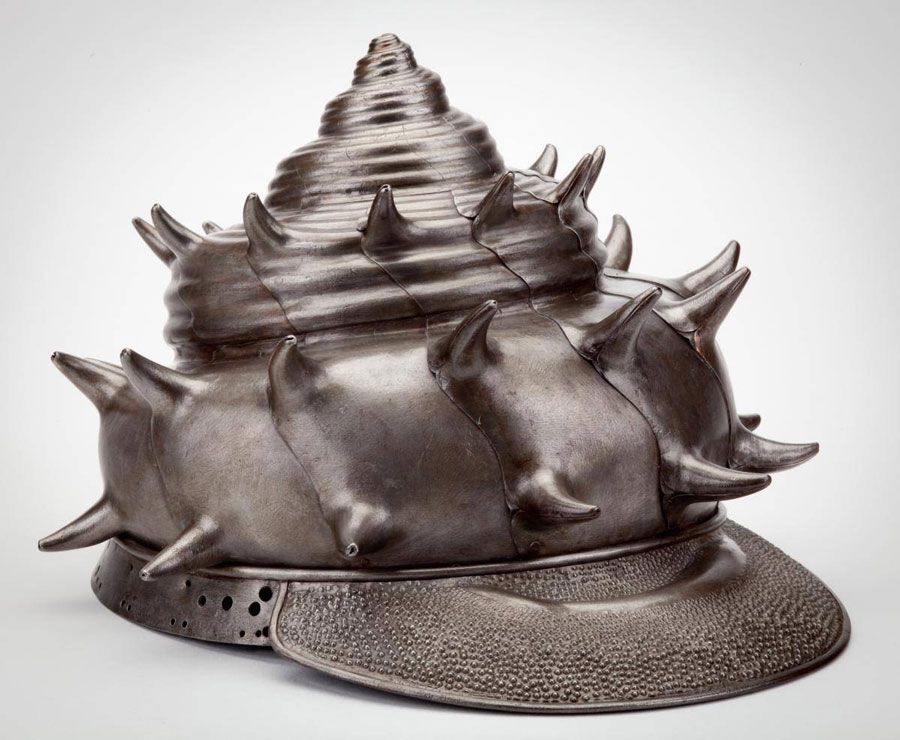
The Art of Armor at the Denver Art Museum Close Helmet for the Foot Tourney - about 1590 - Southern GermanNagasone Tojiro Mitsumasa - Helmet in the form of a Sea Conch Shell - 1618 From 15 May to 5 September 2022, the Denver Art Museum presents "Age of Armor: Treasures from the Higgins Collection at the Worcester Art Museum". Source: Denver Art Museum - Images: Close Helmet for the Foot Tourney, about 1590. Southern German, from the area of Augsburg. Steel, brass and leather fragments, steel formerly blued) with etching and gilding, and brass, 31.8 × 22.9 × 34.3 cm (12 1/2 × 9 × 13 1/2 in.), The John Woodman Higgins Armory Collection, 2014.1113. Image © 2021 Worcester Art Museum, all rights reserved ·· Nagasone Tojiro Mitsumasa, Helmet in the form of a Sea Conch Shell, 1618, iron with traces of lacquer, textiles, 22.9 × 30.5 × 26.7 cm (9 × 12 × 10 1/2 in.). The John Woodman Higgins Armory Collection, 2014.89.1 Although its primary function seems to distance it from the traditional concept of Art, armor was in many cases created with a care and an aesthetic and allegorical sense that makes it pieces of craftsmanship of very high value. The exhibition in Denver includes more than 80 objects from the Higgins Collection, as well as several pieces from the Denver Art Museum's own collections. "Armor served a protective function, but it also held—and in many ways still holds—a mythological role," explained Christoph Heinrich, Director of the DAM. "We want to show where armor fits in history and in the imagination," said Douglas Wagner, associate curator of Asian art at the Denver Art Museum. "Many visitors already have an idea in mind when they think of armor—the ‘knight in shining armor’ is a vivid image and has a powerful ability to fire people’s imaginations. However, the actual context surrounding these objects is equally fascinating and impactful. With this exhibition, we hope visitors will discover how armor and the people who wore it influenced society and ideals—from status and moral character, to ambition and nostalgia—and how those threads run throughout history." Most of the works included in the exhibition were created in Europe during the 15th, 16th and 17th centuries. In a press release, the Denver Art Museum explains that the exhibition is organised thematically into seven sections, "first introducing the parallel roles of armor—the ideal and the pragmatic. ‘The Ideal’ examines how armor influenced social perceptions and how, in turn, it became a canvas for those perceptions. ‘The Reality’ highlights armor on the battlefield and in tournaments, where armor’s protective qualities were crucially important. ‘Artistry & Craftsmanship’ focuses on the beauty of armor and the techniques utilized in crafting the pieces. A related section observes ‘Armor as Fashion’ and as a reflection of trends at the time. ‘Who Wore Armor?’ humanizes the objects, looking at the people who donned armor, and what they represented to their communities and contemporaries. ‘The Changing Nature of Warfare’ examines how new technology and military approaches transformed armor, both on the battlefield and in the social consciousness. ‘Enduring Legacies’ focuses on armor’s ability to remain a powerful symbol to the present day”.
Read the full article

